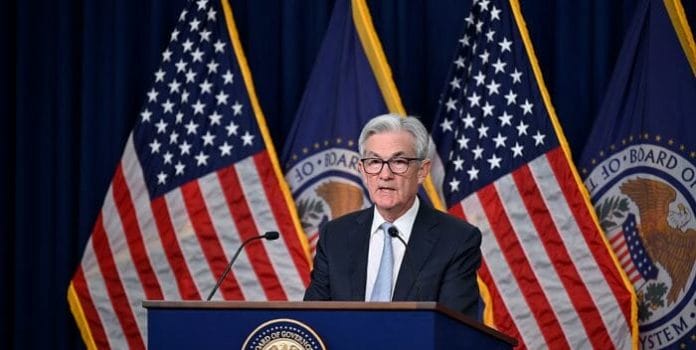This week, the US 10-year bond yield pulled back sharply from a 16-year high above 5%, breaking below the key 4.8% technical support level, and the USD retreated. The drivers: a less hawkish policy outlook from the Fed, weaker US manufacturing sector data and easing concerns about the US Treasury’s more moderate bond issuance plan for Q4. Lower US bond yields typically help the more rate-sensitive, faster-growing equity markets.
Hence, analysts at Standard Chartered believe the retracement of bond yields opens a window for US equities to recover in the near term from a three-month correction. Investors with 6-12-month horizon still have an opportunity to add high-quality Developed Market (DM) government bonds within a broadly diversified portfolio.
A mellower Fed: Fed Chair Powell’s tone this week, after the US central bank held rates for the second straight meeting at a 22-year high, was unmistakably mellower than before. Powell stressed that the risks around the Fed doing too much or too little to fight inflation were more balanced. Indeed, US core PCE inflation is likely to fall below the Fed’s 3.7% y/y estimate for Q4 (the Fed’s preferred measure of inflation had already slowed to 3.7% in September, with base effects likely to drag it lower in Q4). Powell’s comments, which followed a similarly milder tone from ECB President Lagarde last week and BoE Governor Bailey this week (the BoE also held rates for the second straight meeting), suggest the world’s major central banks are done with hiking rates in this cycle. Markets have also pared back expectations of another rate hike by the Fed and BoE and have started to price in rate cuts by the ECB from April.
Slowing economies: As inflation slows, policy focus is likely to turn towards the growth outlook. US growth is likely to slow significantly in the coming quarters. The Atlanta Fed GDPNow is estimating 1.2% growth in Q4 vs. 4.9% expansion in Q3. US real (inflation-adjusted) interest rates, running at 15-year highs close to 2.5%, are starting to hurt the broader economy, with consumer and corporate delinquencies rising. The summertime consumption spree is likely to fade as a resumption of student debt payments curbs disposable income. Meanwhile, the Euro area economy contracted in Q3. Yet, the Fed, ECB, and BoE are unlikely to cut rates soon, given inflation remains well above their 2% target and job markets stay tight. As central banks hold rates longer, financial conditions are likely to tighten further.
Conviction in DM government bonds: This week’s sharp pullback in the US 10-year bond yield and Powell and Lagarde’s comments solidify our belief that we are near the cyclical peak in bond yields. Historically, peak policy rates have signalled a cyclical top in yields. We would continue to use the opportunity to add exposure to US and European government bonds.
US equities, EM bonds: US stocks are likely to gain the most from lower bond yields since the market is heavily weighted towards rate-sensitive technology and communication services sectors. The S&P500 index has rebounded above its 200-day moving average (DMA) amid stronger-than-expected Q3 earnings. Technically, it needs to break above the next key resistance around 4,394 to break the pattern of lower highs and lower lows since July; EM local currency government bonds are also likely to benefit as the USD peaks with bond yields. A break in the USD index (DXY) below its 50DMA of 105.6 is likely to lead to a test of 104.7. Brazil’s central bank cut rates this week for the third time in this cycle; other EM central banks are likely to cut once they gain confidence the USD has peaked.
Hedging Middle East risk: The Israel-Gaza conflict has remained largely confined to Gaza, with other regional powers, notably Iran, staying away. However, Israel’s ground operations risk a wider flare-up. Gold has rallied since the conflict broke out; it remains a time-tested hedge against short-term spikes in volatility. Although oil prices have retreated as the conflict stays confined, energy sector equities remain a viable hedge against any escalation that disrupts oil supplies from the Middle East.









